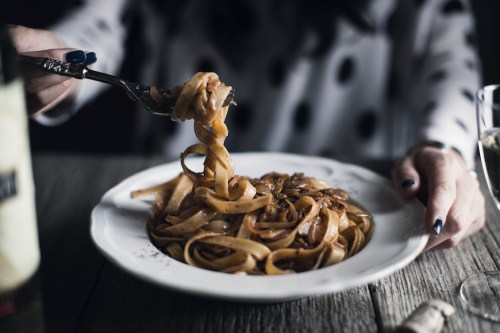Our editors independently select these products. Making a purchase through our links may earn Well+Good a commission
The science-backed reasons why we crave heartier foods during the winter months
A neuroscientist and a registered dietitian explain why cravings for hearty winter comfort food is so strong once the weather gets colder.

Like many people, I’m more active when the outdoor temperatures don’t require me to leave the house looking like a human down comforter. In T-shirt weather—and even sweater weather—I’ll take every opportunity to go for an outdoor run or get my errands done by walking instead of hopping in the car.
Winter is a different story. When it’s dark and cold, I’m way less likely to pull myself out of bed for a morning workout and once I come home in the evening, I’m in for the night. There’s absolutely no doubt that I’m way less physically active—which is why I’m confused that my appetite essentially doubles during the colder months. Salads and fresh fruit are perfectly satisfying in the summer. But this time of year, not only am I more hungry, I start to crave big bowls of pasta, chili and cornbread, and just-baked brownies. Can you relate?
To get to the bottom of why it’s human nature to look for cozy, comfort foods during the winter, I consulted neuroscientist and Why You Eat What You Eat author Rachel Herz, PhD and registered dietitian Olivia Wagner, RD.
Hearty foods make us happy
This probably won’t come as a shocker, but foods we think of as comfort foods lead to a short-term mood boost. “Foods high in carbs and fats trigger a release of dopamine, endorphins, and serotonin, so they’re definitely triggering chemicals in the brain that make us feel good,” Dr. Herz says. This connection isn’t seasonal—it’s always there—but she points out that many people feel at least a slight drop in mood when the weather is bleak, which can lead to a greater need for that chemical mood boost.
There’s also a nostalgia factor at play. “Many comfort foods are nostalgic of childhood and can make us feel like we’re getting a warm hug from a parent,” she says. (Though she adds this connection is only there for people who have primarily positive childhood memories.) “It’s not unusual for some people to feel lonely in the winter time. This time of year, there’s a general longing to be more connected to family.”
From a nutrition standpoint, Wagner says it’s 100 percent okay to go with your cravings every now and then, but she recommends tuning into your body while you eat. “You can certainly enjoy foods that are nostalgic without spiraling out of control,” she says. “By employing mindfulness at mealtime, allowing yourself to taste the flavors, savor the experience, and be present with the meal should increase satisfaction with a smaller amount,” she says.
Check out this video to see which foods will give you an energy boost:
You see it more often—which impacts your cravings
Take a casual scroll through your Instagram feed (or step into virtually any restaurant) during the winter months and you’re much more likely to see images of cheesy casseroles, pot pies, and of course lots of festively decorated treats. Just seeing more of these types of foods has a profound effect on the brain, Dr. Herz says. “Visuals are extremely compelling when it comes to our cravings for foods,” she says. “Today, the way food is portrayed, it’s practically porn. You look at these gorgeous photos and it really makes you want what you see!”
Dr. Herz says that researchers who performed experiments showing people photos of specific foods, such as pizza, found that photos can lead to cravings—until someone is completely overloaded with images. If you see too much of a food, you actually stop craving it. This concept is known as habituation—basically, if your brain is exposed to a certain stimulus over and over, it no longer because exciting to it, and thus your brain stops reacting to it. She says this works similarly with smell: If you walk by a Cinnabon in the mall, the smell of the sweet pastries can lure you in. But if you were to smell cinnamon buns every single day for a few days or weeks, the craving will likely go away.
Especially around the holidays, there’s also the mentality that this is the only time of year to have certain foods, such as peppermint bark, gingerbread lattes, or pumpkin bread. To this, Wagner reiterates that it isn’t unhealthy to enjoy your favorite seasonal foods—no need to deprive yourself of your mom’s pecan pie—but, again, really savor it so the experience itself is richer and more meaningful, instead of just eating a plate full of sugar cookies while watching Netflix.
While craving heartier food in winter doesn’t seem to serve a purpose in terms of providing energy, it does make sense that the cravings stem from subconsciously wanting to be comforted more, feeling warm, and of course because we see them virtually everywhere. The best response to this, according to Wagner, isn’t to push these cravings away; it’s just to be mindful. And really, that’s a food habit that’s worth putting into practice year-round, wouldn’t you say?
Here’s why eating while you watch TV is so satisfying. And yes, food porn is pretty, but it’s a lot of work. Here, a real life food blogger shares what the process is *really* like.
Sign Up for Our Daily Newsletter
Get all the latest in wellness, trends, food, fitness, beauty, and more delivered right to your inbox.
Got it, you've been added to our email list.










